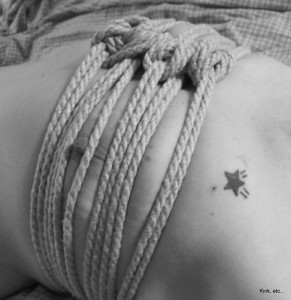With a few basic knots you can bind your lover erotically. It’s not as difficult as you might think. The key is to know your knots inside and out. Practice makes perfect and you should be able to tie your knots from brain power alone.
There are many wonderful resources scattered across the internet, to help you help learn knots and bondage. Rather than try to duplicate the information, I’ll attempt to organize the links and information in an easy to use resource list.
Glossary of terms used for working with rope:
Bend - A bend is used to tie two ropes together. Such as a Sheet Bend and a Reef knot.
Bight - A semi-circle of rope where the rope does not cross itself; also the part of the rope between the standing part and the end that can be used in tying the knot.
Bight can have two meanings:
The main part of the rope from the running end to the standing end, also known as Standing Part
Where the rope is bent back to form a loop. An open curve in a line
Running or Bitter End - The end of the line that you work with in tying knots.
Dress - To remove slack in the knot by drawing up the knot neatly. Making sure the knot is tied correctly and all the parts lay the way they should.
Friction Hitch - A knot tied directly to the standing part, another rope, or a cylindrical object that is adjustable and can be slid when the knot itself is physically moved. Stays put from friction when load bearing.
Hitch – A knot that attaches a rope directly to an object or around itself or onto another rope. Generally, not recommended for load bearing.
Jam - when the knot tightens under tension and you cannot get it undone!
Loop – Sometimes called an eye. Formed when the bight is closed, ie. it crosses the line. A circle of rope in which the rope crosses itself.
Overhand Loop - A loop passing over the standing part.
Set - To fully tighten a knot by pulling on all parts.
Slip - To use a bight of rope instead of the end when finishing tying a knot; used to make untying a knot easier.
Standing End - The static end of the rope.
Standing Part - The main length of line, ie. the part of the rope not used in the knot itself.
Stopper Knots – Used to stop the end of a rope fraying, or to stop it running through a small hole or constriction.
Twist - sort of self explanatory: the line is twisted around another.
Underhand Loop - A loop passing under the standing part.
Body wraps – Generally speaking, are multiple times that the rope is wrapped around the body in one area. There are a few ways to achieve this illustrated by Tut.
More useful information on knots terminology.
Basic Knots
Square Knot -
The first knot you need to know. A simple knot used to tie two ropes together or to cinch around a wrap for continued rope work. It’s a flat knot and won’t put a lot of pressure on the nerves. It can also be used to lash two ropes together. This knot isn’t suggested for load bearing.
Square Knot with one rope-
Square Knot with Lashing – Adds extra security to your knot. With the tail of the rope, make half hitches.
Fisherman’s Bend – Safer than a square knot. Used to make cuffs or a body wrap with a slip free knot.
Hitches –
These knots are two of the easiest to tie and work well when securing a rope to a bedpost or another stationary object. However, they can cut off circulation when struggling or under a load. They should not be used for suspension or tied around the body. However, they can be tied around a body wrap during floor work.
Clove Hitch Using Standing Ends
Clove Hitch Using Loop or Bight
Clove Hitch with Two Half Hitches
Bowlines –
A non-slipping knot that holds up to struggling and also suspension without slipping under tension or a load. It can be used to make a cuff or body wrap.
One rope – To make a wrap
Single rope Bowline
French Bowline - made with a doubled rope.
Bowline on a Bight – Good for attaching to body wraps knot won’t slip under a load.
Birmingham Bowline – When tied makes a V similar to suspension cuffs. Safe for partial suspension.
Somerville Bowline – Cuff knot that doesn’t slip that’s best used for tying one limb.
Reverse Somerville Bowline - Used when you want to tie a single column that’s already attached to something where you want the rope between the two to stay tight. Commonly used to distribute the weight between a waist harness and a leg wrap.
Column Ties -
Single Column Tie – Good for making a single limb cuff.
Double Column Tie - Used to bind two limbs together.
Various Knots -
A non-slipping knot that can handle a load. Can be used to make quick cuffs or used around wraps. Safe for suspension, often used around body wraps.
Bow Tie knot or Hand Cuff Knot –
Used without the finishing knot.
Used for lengthening or shortening two ropes tied together.
Leon’s capture knot/ half hitch –
Great for making body wraps creates a secure knot that’s safe for load bearing.
A cuff used for suspension or heavy play.
Can be used for a body harness.
Box Knot –
Decorative knot for body harnesses.
Decorative knot – A consistent and flat version of an over hand knot used for body harnesses, dragon fly sleeves and other applications.
Used to join two folded ropes.
Safety and Storage Knots -
Stopper Knot –
Used for the ends of a rope.
Adds extra safety in case a primary knot slips.
Used for storing rope, it’s easily uncoiled with one hand or even your teeth.











![e[lust]](/wp-content/uploads/2013/08/elustbutton200-2.jpg)










 Twitter
Twitter Facebook
Facebook
Pingback: « House of HellKat House of HellKat